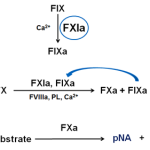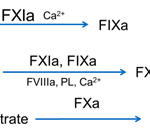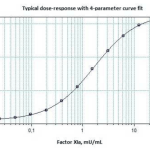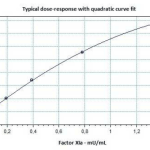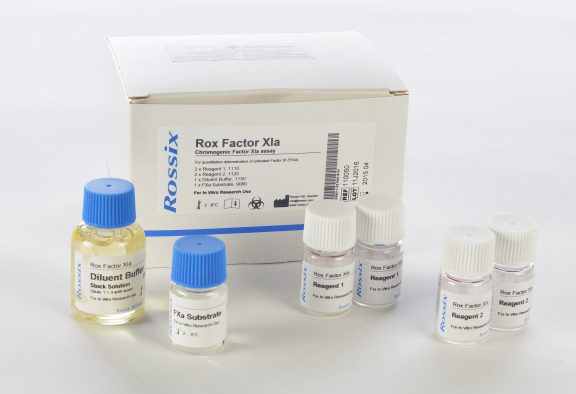
Rox Factor XIa
$0.00
Rox Factor XIa is a chromogenic assay kit based upon FXa generation for quantitative activity determination of Factor XIa in enriched or highly purified protein preparations. Not intended for analysis of plasma.
- Detection Limit = about 0.03 mU/mL
- No use of human plasma
Measurement Principle
Human FXIa is determined from its activation of human Factor IX and ensuing activation of human Factor X. Generated Factor Xa is then measured with a chromogenic FXa substrate.
The activation of Factor IX is performed in two steps:
- Initial activation of FIX in the absence of phospholipids.
- Continued activation of FIX in the presence of FX and phospholipids, therewith allowing concomitant activation of FX.
Typical dose-response curves
See Graphs
Background
Factor XI (FXI) has been identified as a risk factor for both arterial and venous thromboembolism (Ref 1-3). Plasma fractionation procedures may sometimes be associated with inadvertent activation of hemostasis zymogen proteins such as FXI and Factor XIa (FXIa) can be a contaminant in intermediate or final products such as immunoglobulins (IgG). Thromboembolic events have been reported to occur after intravenous administration of IgG and ensuing detailed analyses appeared to link these events to the presence of FXIa in the administered IgG batches (4-7). Routine tests such as the NAPTT may not be sufficiently sensitive to detect relevant low levels of FXIa, possibly partly explained by matrix interference. Rox Factor XIa offers a highly sensitive chromogenic method for determination of sub-picomolar levels of FXIa, therewith allowing high sample dilutions and minimizing interference from the sample matrix and from contaminating proteins such as kallikrein, zymogen FXI and FIXa.
Read more…
- Meijers JCM, Tekelenburg WLH, Bouma BN, Bertina RM, Rosendaal FR.
High levels of coagulation factor XI as a risk factor for venous thrombosis.
N Engl J Med 342, 696-701 (2000). - Doggen CJM, Rosendaal FR, Meijers JCM.
Levels of intrinsic coagulation factors and the risk of myocardial infarction among men: Opposite and synergistic effects of factors XI and XII.
Blood 108, 4045-4051 (2006). - Suri MFK, Yamagishi K, Aleksic N, Hannan PJ, Folsom AR.
Novel hemostatic factor levels and risk of ischemic stroke: the Atherosclerosis Risk in Communities (ARIC) Study.
Cerebrovasc Dis 29, 497-502 (2010). - Woodruff RK, Grigg AP, Firkin FC, Smith IL.
Fatal thrombotic events during treatment of autoimmmune thrombocytopenia with intravous immunoglobulin in elderly patients.
Lancet 2, 217-218 (1986). - Caress JB, Hobson-Webb L, Passmore LV.
Case-control study of thromboembolic events associated with IV immunoglobulin.
J Neurol 256, 339-342(2009). - Foster R, Suri A, Filate W, et al.
Use of intravenous immune globulin in the ICU: a retrospective review of prescribing practices and patient outcomes.
Transfus Med 20, 403-408 (2010). - Etscheid M, Breitner-Ruddock S, Gross S, Hunfeld A, Seitz R, Dodt J.
Identification of kallikrein and FXIa as impurities in therapeutic immunoglobulins: implications for the safety and control of intravenous blood products.
Vox Sanguinis 102, 40-46 (2012). - Lindquist PA, Fujikawa K, Davie EW.
Activation of bovine Factor IX (Christmas Factor) by Factor XIa (Activated Plasma Thromboplastin Antecedent) and a protease from Russell´s Viper Venom.
J Biol Chem 253, 1902-1909 (1978). - Walsh PN, Bradford H, Sinha D, Piperno JR, Tuszynski GP.
Kinetics of the Factor XIa catalyzed activation of human blood coagulation Factor IX.
J Clin Invest 73, 1392-1399 (1984). - Tans G, Janssen-Claessen T, van Dieijen G, Hemker HC, Rosing J.
Activation of Factor IX by Factor XIa – a spectrophotometric assay for Factor IX in human plasma.
Thromb Haemost 48, 127-132 (1982).
